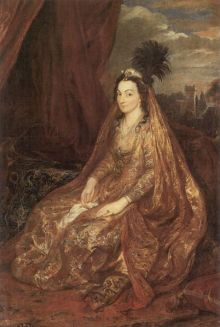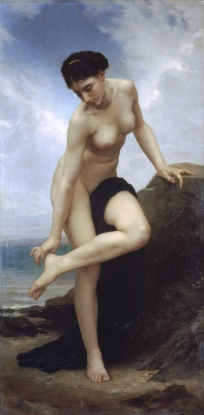Barnby and Jenkins are discussing the prospect of St. John Clarke writing an introduction to the book on Isbister’s paintings. We have already learned some of Clarke’s artistic tastes from his comments on the Keningston Garden statues. In the dialogue, Powell touches on many aspects of the evolution of Modernism.
Jenkins: “St. John Clarke does not know a Van Dyck from a Von Dongen” [AW 31/25]
Almost the only thing these two Dutch painters share is the first four letters of their names and perhaps a penchant for unusual hats. Jenkins has already mentioned Van Dyck, the seventeenth century British court painter, in AQ. Van Dyck painted portraits of Lady Shirley and her husband in Rome.
Lady Shirley
Anthony Van Dyck, 1622
oil on canvas
H.M. Treasury and The National Trust, Petworth House (Sussex)
photo from the Yorck project via Wikimedia Commons
Powell, reviewing a book about Van Dyck, says: “One is struck by the manner in which van Dyck has treated the Shirleys as if they might be more exotic ramifications of the East India Company in 1840.” [SPA… p. 180]
Van Dongen (1877-1968) was a fauvist, who later identified with the German expressionists. We know nothing about the model for this portrait, but early in his career, Van Dongen did frequent the Rotterdam red light district and often painted its denizens. By the late 1920s, he was honored with the French Legion of Honor and the Order of the Crown of Belgium.
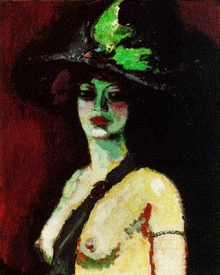 Woman with a Large Hat
Woman with a Large Hat
Kees Van Dongen, 1906
photo public domain in US from Wikipedia
Copyright presumed to be estate of Kees van Dongen.
“Ah, but he does now,” said Barnby. “That’s where you are wrong. You are out of date. St. John Clarke has undergone a conversion.”
“To what?”
“Modernism”
“Steel chairs?”
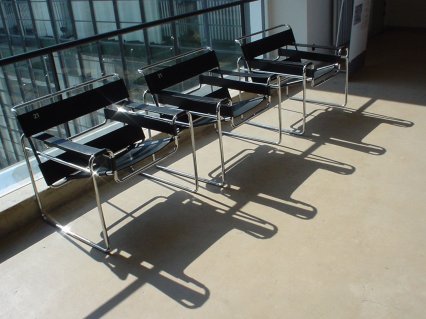
Wassily Chairs, Model B3
Marcel Breuer, 1925-6
Creative Commons license from Wikimedia Commons, contributed by Tankwart from Flickr
While working at the Bauhaus, Marcel Breuer (1902-1981) designed this chair made of extruded chrome-plated steel, just like a bicycle frame, and upholstered with canvas. Breuer named it after the painter Vassily Kandinsky, his friend who was also with the Bauhaus at that time. Copies remain commercially available.
“No doubt they will come.”
“Pictures made of shells and newspaper?”
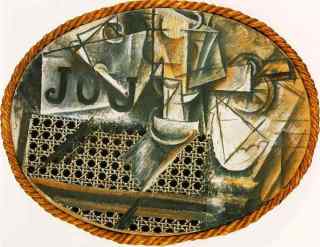
Still Life with Chair Caning
Pablo Picasso, 1912
collage on canvas
Musee Picasson, Paris
copyright Succession Picasso,
In May, 1912, Picasso introduced the low-art tradition of decorative collage to modern high-art practice (Edwards and Wood, Art of the Avante Garde, Yale University Press) with his Still Life with Chair Caning. Braque soon responded with his own collages, both artists gluing found materials onto their canvases. The use of actual newsprint and bits of shells was to follow, but Picasso anticipates this in Chair Caning with the JOU, hinting at “journal,” French for newspaper, and the three connected arcs in the lower right, suggesting a scallop shell.
“At present he is at a slightly earlier stage…The outward and visible sign of St. John Clarke’s conversion … is that he has indeed become a collector of modern pictures — though as I understand it, he still loves them on this side of Surrealism. As a matter of fact he bought a picture of mine last week.” Barnby goes to to say that he expects to be commissioned to paint Clarke’s portrait.
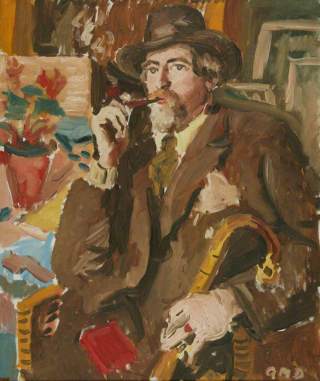
Augustus John
by Adrian Maurice Daintrey
oil on canvas 31 by 26 inches
Manchester Art Gallery
from BBC Your Paintings
(c) Mr Vernon C. Wallis (great-nephew); Supplied by The Public Catalogue Foundation
Barnby is thought to be based in part on Powell’s good friend Adrian Daintrey (1901-1988), to whom AW is dedicated. In Daintrey’s portrait of the artist Augustus John, we see bold brush strokes and splashes of color to contrast with the brown suit, which probably owe something to his heroes Matisse and Derain, a modern portrait style that might accommodate the limits of Clarke’s ‘conversion.’
Considering whether Clarke’s conversion would improve his life, Jenkins says: “But if you are not really interested in pictures, liking a Bonard doesn’t make you any happier than liking a Bouguereau.” [AW 33/27]
- Nude After the Bath
William-Adolphe Bouguereau, 1875
photo public domain from Wikipedia.org
William-Adolphe Bouguereau (1825-1095) was a French academic painter who often placed his realistic but idealized nudes in mythical or classical settings. He was very successful in the mid nineteenth century but was devalued by the Impressionists and their followers. “Degas and his friends used the term ”bouguerated” (bouguereauté) to derogate a finicky, overly finished painting surface.” (Grace Glueck, The New York Times 1/6/1985) Bouguereau was quite out of favor among modernists in the days of AW, but like his contemporary Alma-Tadema, had new admirers later in the twentieth century.
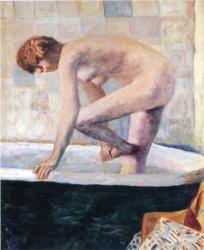
Nude Washing Feet in Bathtub
Pierre Bonnard, 1924
oil on canvas, 42 x 38 in.
Private Collection,
copyright status unknown
image from Wikipaintings. org
Bouguereau‘s countryman Pierre Bonnard (1867-1947) practiced a very different form of realism, sometimes called Intimism. He often worked from photos of his wife Marthe, using small brush strokes and colors mixed optically on the canvas to capture skin tones. Bonnard was a friend of Toulouse-Lautrec and was influenced by Gaugin and japonisme. He was riding the modern wave in the days of AW, with a major exhibition at the Art Institute of Chicago in 1933.
